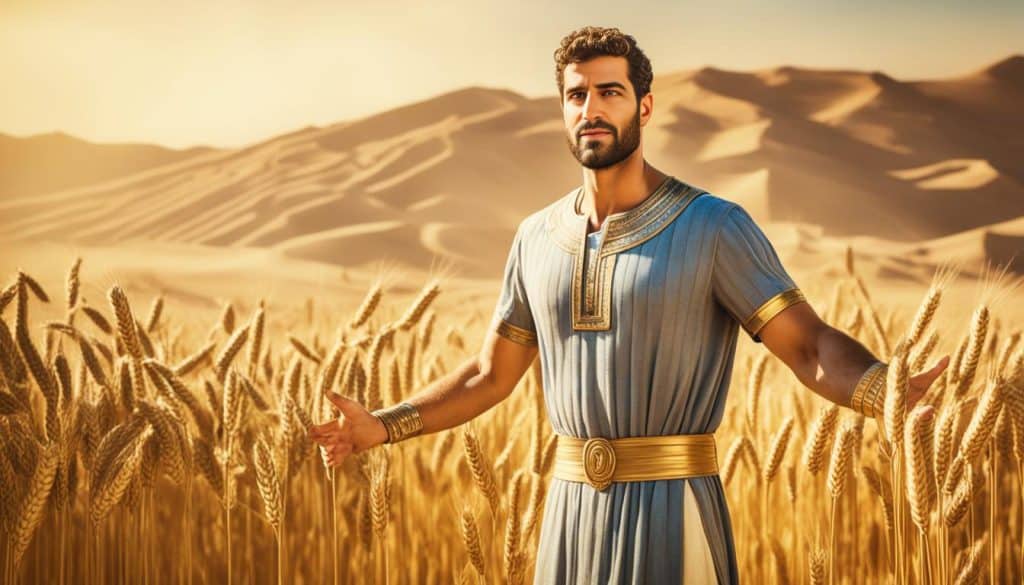Table of Contents
Have you ever thought about the stories of Zion’s Exiles in the Bible?
How did they survive their captivity and return to their homeland?
Let’s explore the powerful lessons in their journey, revealing insights into salvation and redemption.
The stories of Zion’s Exiles spark curiosity and challenge common beliefs. These tales cover the Babylonian captivity, the return from exile, and remarkable journeys of figures like Joseph and Daniel.
They also include Esther, Jonah, and the prodigal son. Each story offers glimpses of salvation and hope.
But what deeper meanings do these stories hold?
Join us as we dive into the shadows of redemption seen in the Babylonian captivity. We’ll see how the exodus prefigures liberation through Christ. And discover salvation’s echoes in the return from exile.
We’ll also compare Joseph’s rise in Egypt to Christ’s exaltation. Daniel’s deliverance shows faithfulness rewarded. Esther’s story hints at Christ’s mediation role.
We’ll explore Jonah’s three days in the fish as a sign of Christ’s resurrection. The prodigal son’s tale teaches about return and forgiveness. Isaiah’s prophecies foretell Christ’s life and sacrifice as the suffering servant.
We’ll also look at the new Jerusalem as a symbol of ultimate restoration and hope in Jesus.
Get ready to be captivated by these ancient stories, for they contain timeless truths. They still speak to us today. Dive into these narratives to deepen your understanding of God’s plan for humanity. Find inspiration in Zion’s Exiles’ experiences.
The Babylonian Captivity: A Shadow of Redemption
The Babylonian captivity was an important time for Zion’s Exiles. It showed what happens when we drift from God. This period reminds us of our need for redemption because of sin.
The Babylonians took over Jerusalem and moved many people to Babylon. This punishment came because the Israelites did not follow God. Their worship of idols showed their broken bond with Him.
“By the rivers of Babylon, there we sat down, yea, we wept, when we remembered Zion.” – Psalm 137:1
In Babylon, the Israelites missed their land, temple, and God’s presence deeply. They mourned together and individually for their loss. They longed to be redeemed.
Even in hard times, they found hope. Prophets like Jeremiah and Ezekiel spoke of coming back home. They promised God’s faithfulness and a plan for freedom.
The story of their captivity is like a story about all people. It shows how sin separates us from God. It teaches us about fixing that relationship and coming back together.
Like the Israelites wanted to leave captivity, we want to escape sin’s effects. We all wish to be close to our Creator again.
The story of Babylon teaches us about God’s love and grace. It shows us how Jesus brings us the ultimate redemption.
Now, let’s look at key figures and stories from this time to learn more.
Key Figures and Narratives of the Babylonian Captivity
We’ll dive into these stories and more. They are full of faith, hope, and lessons of redemption.https://www.youtube.com/watch?v=6e1mj3xUAQ4
| Figure | Narrative |
|---|---|
| King Nebuchadnezzar | The conqueror of Jerusalem and the one who initiated the Babylonian captivity. |
| Daniel | A faithful servant of God who rose to prominence in Babylon and showcased unwavering faith even in the face of adversity. |
| The Fiery Furnace | The story of Shadrach, Meshach, and Abednego’s refusal to bow down to false gods, leading to their miraculous deliverance from the fiery furnace. |
The Exodus: Prefiguring Liberation through Christ
The Exodus story is a key Bible event. It shows how the Israelites were freed from Egypt’s slavery. This event is a preview of how Christ frees us from sin.
The Exodus tells a memorable liberation story. It shows God’s power to free His people. The Israelites were slaves in Egypt for a long time. Yet, through Moses, God performed miracles like the ten plagues and splitting the Red Sea for their escape.
The Exodus was more than a physical freedom story. It hints at the spiritual freedom Christ brings. Christ is seen as the one who frees us from sin and death’s grip. His life, death, and resurrection open a way to God and true freedom.
Jesus said, “If the Son therefore shall make you free, ye shall be free indeed.”
In Exodus, God made a way for the Israelites to avoid enslavement. He started Passover, where lamb’s blood saved them from Egyptian judgment. This act foretold Christ’s sacrifice. Christ is the Lamb of God, saving us from sin’s consequences.
The Israelites’ desert journey after freedom also has a lesson. It shows that freedom from sin is just the start. It’s the beginning of living by God’s laws.

The Exodus story is a solid example of God’s faithfulness and power to save. It shows God freeing the Israelites from physical chains. Similarly, Christ frees us from the spiritual chains of sin. The Exodus story prefigures the freedom Christ offers to believers.
Return from Exile: Echoes of Salvation
After years of captivity, Zion’s Exiles saw a light at the end of the tunnel – a chance to return home. This event opened a new chapter full of hope and the promise of a fresh start.
Their journey back symbolized more than just a physical return; it mirrored our spiritual journey towards God through Jesus. Just as they were freed and given a new beginning, we too have the chance to escape sin’s hold and find salvation.
“Return unto me, and I will return unto you, saith the Lord of hosts.” – Malachi 3:7
God’s plan for healing and renewal was shown in this return. It reminded everyone of His constant love and loyalty. This event was like an open door to salvation, offering a fresh start and the joy of reuniting with the Lord.
In the same way, our return to God, thanks to Jesus’s sacrifice, makes us closer to the Creator. This return offers healing, forgiveness, and the precious gift of eternal life.
Finding Salvation in Return
Thinking about this return reminds us of its impact on Zion’s Exiles. Their return was more than coming home; it was about freedom and being saved. Likewise, our spiritual comeback to God brings the wonderful gift of salvation.
- Salvation from Sin: Freed from captivity, we’re also freed from sin by Jesus’s death.
- Salvation through Grace: Just as God’s grace was shown, our return is made possible by His endless love.
- Salvation for Restoration: Their return started a time of building anew. Our return opens the door to personal transformation.
This return speaks of salvation – a message filled with hope, reconciliation, and eternal life promise. It’s an open invitation to everyone, calling us to come home to a God who waits lovingly.
| Biblical Narrative | Symbolism |
|---|---|
| Zion’s Exiles returning from Babylonian captivity | Echo of spiritual return to God through Jesus |
| Reconciliation and restoration of Israel | Represents God’s plan for reconciliation and restoration for all humanity |
| Freedom from captivity | Signifies freedom from the bondage of sin |
| Opportunity for a fresh start | Invites individuals to experience new life and salvation in Christ |
Joseph’s Rise in Egypt: A Type of Christ’s Exaltation
Joseph’s journey from a prisoner to a prince in Egypt is a powerful story. It mirrors Jesus’ resurrection and ascension. Joseph’s rise shows us divine care, forgiveness, and how relationships can be mended.
Joseph, Jacob’s beloved son, was betrayed by his brothers and sold into slavery. He faced false accusations and jail time, but his faith in God never wavered. This faith helped him climb to power in Egypt.
Joseph’s suffering and jail time led to his high position in Egypt, similar to Jesus. Jesus faced death and then was resurrected and ascended to heaven.
And Joseph said unto his brethren, “But as for you, ye thought evil against me; but God meant it unto good, to bring to pass, as it is this day, to save much people alive.” – Genesis 50:20
This quote is Joseph making peace with his brothers. He realized that through his struggles, God was working. This was for a greater good, just like Jesus’ death was part of a larger plan for saving mankind.
Joseph’s success in Egypt points to Christ’s greater victory and rule. Both faced tough times, yet ended up in powerful roles.
Joseph’s story teaches us about forgiving others and fixing what’s broken. He chose to forgive his brothers rather than getting back at them. This shows how forgiveness can heal and mend fractured ties.
Joseph’s life also tells us that tough times can lead to good. God uses these moments to achieve His goals. Just like Joseph saved many, Jesus’ resurrection offers eternal life to believers.
The Lessons of Joseph’s Story
Joseph’s tale is a deep lesson in forgiveness, healing, and faith despite challenges. Here’s what we can learn:
- Forgiveness: Joseph forgave his brothers, showing how forgiveness can heal wounds and bring people together again.
- Restoration: His reunion with his family symbolizes God’s wish to heal our lives and reconcile broken bonds.
- Faith in God’s sovereignty: Joseph’s steady faith even in hard times inspires us to lean on God’s plan and wisdom.
Joseph’s rise from being captive to becoming a revered figure is a vivid prelude to Christ’s victory. It gives hope and motivation to everyone facing tough times.

Comparison of Joseph’s Rise in Egypt and Christ’s Exaltation
| Joseph’s Rise in Egypt | Christ’s Exaltation |
|---|---|
| Imprisoned and humbled | Crucified and died |
| Elevated to power and authority | Resurrected and ascended to heaven |
| Used by God to save many lives | Brings salvation to all who believe |
The table shows us how Joseph’s elevation in Egypt and Christ’s higher calling share similarities. Both narratives reveal the incredible effects of God’s love, forgiveness, and healing power.
Daniel in the Lion’s Den: Faithfulness Rewarded
Daniel’s strong faith and trust in God is shown in the story of his survival in the lion’s den. This amazing tale highlights Daniel’s faith. It also hints at Christ’s victory over death.
Despite a royal order, Daniel kept praying to the God of Israel without wavering. For this, he was thrown into a den with hungry lions. Yet, by God’s intervention, he walked out unharmed the next morning. His escape is a sign of his strong faith and God’s loyalty to His followers.
Like Daniel faced the lions, Jesus faced death willingly. His resurrection shows His win over sin. It brings hope of salvation to everyone who believes. God saved Daniel from the lions just as He saves us from sin through Christ.
Daniel’s brave faith and his escape teach us to always trust God, even when things are tough. It reminds us that staying faithful is rewarded. Daniel’s story shows us God’s reliability. He keeps His promises and helps us through hard times.
“The God of Daniel is a mighty deliverer. Trust in Him, and He will never fail you.”
Daniel’s story encourages us to stay true to God, trusting His everlasting faithfulness. Facing our problems, we can draw strength from Daniel’s example and Christ’s final victory. This helps us trust in God’s endless love and care for us.

| Daniel’s Faithfulness | Christ’s Victory |
|---|---|
| Remained loyal to God despite adversity | Overcame sin and death through His sacrifice |
| Experienced deliverance from the lion’s den | Conquered death and rose again |
| Served as a testament to God’s faithfulness | Offers salvation and eternal life to believers |
Esther’s Intercession: A Foreshadowing of Christ’s Mediation
Esther was a Jewish queen who played a key role in saving her people. She risked her life by approaching the king. This act is similar to how Jesus saved humanity through His sacrifice.
Jesus advocates for us before God, asking for our redemption and forgiveness. His sacrifice allows us to have eternal life. Esther’s brave actions predicted the salvation Jesus offers.
Esther 4:16 (KJV): “Go, gather together all the Jews that are present in Shushan, and fast ye for me, and neither eat nor drink three days, night or day: I also and my maidens will fast likewise; and so will I go in unto the king, which is not according to the law: and if I perish, I perish.”
Esther’s story shows the power of speaking up for others to receive mercy. Like her, Jesus gave His life for our salvation. Through Him, we can be forgiven.
Esther teaches us to be brave and trust in God’s plan. In tough times, we have hope because Jesus is on our side. He fights for our salvation and well-being.
Esther’s Intercession and our Salvation
Esther’s act reminds us that God cares deeply for His people. By trusting in Jesus, we find comfort and healing. His mediation heals our broken relationship with God, offering us eternal life.
Just like Esther saved her people, Jesus offers salvation to everyone who believes. His ultimate sacrifice frees us from sin and promises us eternal life.
Thinking about Esther and Jesus helps us see the power of faith and sacrifice. It encourages us to appreciate Jesus’ role in our lives and to follow Him with all our heart.

Esther’s brave plea is a reminder of God’s immense love for us. Through Jesus, we achieve salvation and eternal life. This shows the vastness of God’s grace.
Jonah’s Three Days in the Fish: A Sign of Christ’s Resurrection
Jonah’s experience of being swallowed by a great fish is a powerful preview of Jesus’ resurrection. As a prophet, Jonah spent three days and nights inside the fish before his miraculous release. This story is deeply meaningful, showing Christ’s victory over death.
Jonah was supposed to go to Nineveh with a message from God. But, he tried to escape his mission by sea. A huge storm made the sailors throw lots, pointing at Jonah as the problem. He admitted his fault and was thrown overboard to save the others.
Inside the fish, Jonah felt lost in darkness. Yet, he prayed, showing his sorrow and promise to obey God. God then made the fish release Jonah, giving him another chance to fulfill his mission.
Jonah’s three days inside the fish are similar to Jesus’ resurrection, which Jesus himself mentioned in Matthew 12:40. This story spotlights Jonah’s ordeal as a precursor to Christ’s resurrection.
Like Jonah, Christ rose after three days, defeating sin and death. This act offers salvation to believers, promising them eternal life with God.
Jonah’s story also shows God’s commitment to saving humanity. Even when Jonah ran away, God led him back. This teaches us that God wants everyone to find salvation and will reach out to even the most reluctant hearts.

In summary, Jonah’s ordeal symbolizes Christ’s resurrection and the hope we have in Jesus. It shows God’s relentless effort to redeem us and the power of turning back to God.
The Prodigal Son: A Story of Return and Forgiveness
This story reminds us of our journey back to God through Christ. It shows us the power of forgiveness and God’s deep love and grace.
A Tale of Redemption and Repentance
A son leaves his home, wasting his wealth on wild living. Soon, he’s poor and sad. Ashamed, he decides to go back to his dad, hoping for a second chance.
“And he arose, and came to his father. But when he was yet a great way off, his father saw him, and had compassion, and ran, and fell on his neck, and kissed him.” – Luke 15:20
Seeing his son return, the father feels a rush of joy. He rushes to hug him. They rejoice in their reunion.
The Power of Forgiveness
This story shows God’s endless forgiveness. Like the welcoming father, God forgives us when we seek His mercy, regardless of our past.
The son’s return marks a new start. His desire to make things right leads to great joy. It shows God’s happiness in forgiving us.
Lessons of Grace and Compassion
Jesus tells us to forgive others as God forgives us. We should show compassion, forgiving like our Heavenly Father.
This story makes us think about our own spiritual path. It tells us God waits for us, no matter what. He’s ready to welcome us with love.
A Call to Embrace Forgiveness and Return
This tale urges us to look at our lives and our bond with God. It invites us to seek His forgiveness and come back to Him.
Just like the son was happy to return, we too can find joy in coming back to God. This story is a powerful lesson in forgiveness.

Isaiah’s Suffering Servant: A Prophetic View of Christ
The Book of Isaiah reveals insights into Jesus’ life and his ultimate sacrifice. It talks about a servant who would suffer yet save humanity. This is found in Isaiah 53, where the servant’s ordeal is detailed.
This servant’s story matches Jesus Christ’s life closely. He was despised and suffered like the servant. Jesus faced betrayal, mocking, and pain. He died to redeem us all.
The servant’s pain was meant to heal others. This idea in Isaiah foresaw Jesus’ sacrifice for us. Through his death and coming back to life, Jesus offered eternal life to believers. He carried the world’s sins.
“But he was wounded for our transgressions,
he was bruised for our iniquities:
the chastisement of our peace was upon him;
and with his stripes we are healed.” – Isaiah 53:5 (KJV)
| Isaiah’s Suffering Servant | Christ’s Life and Sacrifice |
|---|---|
| Despised and rejected by men (Isaiah 53:3) | Rejected by his own people (John 1:11) |
| Wounded for our transgressions (Isaiah 53:5) | Crucified for the sins of humanity (1 Peter 2:24) |
| Led like a lamb to the slaughter (Isaiah 53:7) | Willfully submitted to his crucifixion (Matthew 27:31) |
| Numbered with the transgressors (Isaiah 53:12) | Crucified alongside criminals (Luke 23:33) |
| Made an offering for sin (Isaiah 53:10) | Became the atoning sacrifice for sin (Romans 3:25) |
| Poured out his soul unto death (Isaiah 53:12) | Gave his life on the cross (Mark 15:37) |
| Will see the light of life and be satisfied (Isaiah 53:11) | Rose from the dead, victorious over death (Matthew 28:6) |
The links between Isaiah’s servant and Jesus are striking. They show God’s redemption plan set before Christ was born. This connects Old Testament prophecies with New Testament fulfillments.

Learning about the suffering servant in Isaiah lets us appreciate Jesus’ life more. His sacrifice shows God’s huge love. It shows how far God would go to bring us back to Him.
We will also look at the new Jerusalem in Revelation. It symbolizes God’s final gathering of His people, showing ultimate restoration and hope in Jesus.
How is the concept of “return” explored in the biblical narrative of Zion’s Exiles?
The concept of “return” is central to the biblical narrative of Zion‘s Exiles. It is the promise of the Lord’s return to Zion that gives hope to the exiled Israelites. The idea of restoration and redemption is repeated throughout the Old Testament, emphasizing the ultimate return to the promised land.
The New Jerusalem: A Vision of Ultimate Restoration
The vision of the new Jerusalem in Revelation marks the peak of God’s restoration plan. This city is where God’s people finally come together, leaving behind separation and sadness.
This vision offers hope to believers. It shows us that with Jesus, a complete restoration is assured. The new Jerusalem is about a future free from all damage.
Here, restoration is certain. It’s where every tear is dried and God lives with His people. This city shows God’s loyalty and our hope in Jesus.
We should keep this vision close to our hearts. It encourages us to keep our faith strong, waiting for when God’s restoration is fully revealed. It tells us to hope in Jesus, who renews everything.




